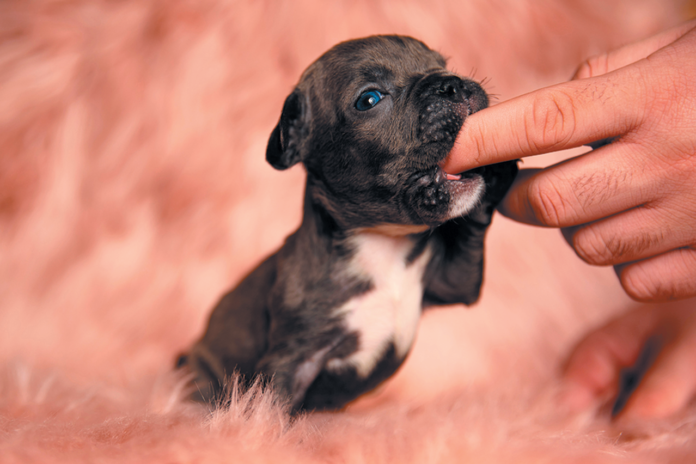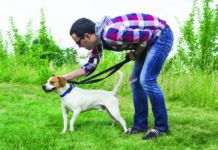A puppy’s adult teeth generally start to come in when she reaches the age of 3 months. It hurts; the new teeth have to cut through the gum line. That’s why she teethes on everything — your furniture, your shoes, your hands. She’s trying to relieve the uncomfortable sensation.
To dull the pain, run a washcloth under water, wring it out, and put it in the freezer until it’s hard. Then give it to the puppy to chew on. Young pups really seem to enjoy gnawing on a nice, icy washcloth (as long as you are watching the whole time to make sure the dog doesn’t swallow it). You can also buy fluid-filled chew rings made specifically for teething. They, too, can be frozen and then given to your pup. Some people run an ice cube over their puppy’s teeth. The cold sensation helps freeze out the discomfort.
The teething will end by the time your dog turns around 6 months. It’s at that point that her adult teeth will have come in — all 42 of them (10 more than people).
But while the teething lasts from about the age of 3 to 6 months, the nipping and biting can start before that — and continue afterwards. And even baby teeth can feel like sharp carpet tacks on your skin. Why do dogs do it?
In part, it’s their way of exploring their world. While people have a pretty good sense of touch on the lips and around the face, most of our touch is felt on our fingers, particularly at the tips. For dogs, the touch receptors are most numerous around the muzzle, that part of the face comprising the nose and mouth and the areas between and around them. In other words, a dog uses her face in many ways like we use our hands. That’s why dogs are sometimes called “mouthy.”
The trick is to teach puppies to use their mouths in a way that won’t destroy your furniture or other goods — or cause you pain. How to do that?
A guide to redirecting the biting
When still with their littermates, puppies teach each other about biting too hard. They nip at each other in play, not recognizing their own strength, and if they chomp with too much force, a “brother” or “sister” will make a loud yelp, and the dog learns to soften her touch.
You need to continue the teaching once you bring your puppy home. When she clamps too hard on your skin, say “Ouch!” very startlingly. And let your hand go limp, or at least pull it away very slowly. If you move too fast, she might think it’s a game and try to “catch” you.
People who find their pup gets worked up when they yell “ouch” can just quietly disengage, even walking away, if need be.
You also have to let your young dog know what is okay to chew on. First, praise her for stopping, even if it’s your actions that made her do it, and then reward her — either by putting your hand nearby so she can mouth it more gently or by giving her a chew toy such as a nylon bone, a sturdy rubber toy, or a Kong with a frozen treat inside. In this way she will learn what animal behaviorists call bite inhibition. That’s the ability to control how hard she clamps down.
Of course, the ultimate aim is to teach your dog that her mouth does not belong on human skin. You can gradually move from instructing her in bite inhibition to a “No bite” cue that’s reinforced with warm praise and treats when she complies.
This is important training, and not just for the moment. Dogs who learn bite inhibition can be counted on to take a treat gently from someone’s hand and might also have an easier time learning “Leave it” when they’re told to let go of something you don’t want them to hold in their mouths.
Other tricks
Part of teaching a dog not to bite you — or objects she’s not supposed to — is providing her with replacement activities.
- While she’s still in the nippy stage, make sure she has plenty of her own toys to satisfy her urge to try things out with her teeth.
- Encourage forms of play that do not involve direct contact, including fetch. Also be sure to train her to “Sit,” “Come,” “Stay,” and so on. At that age, if you occupy a puppy’s mind with lessons in following your simple cues, she will be less likely to engage in activities she’s not supposed to.
Above all, keep in mind that your puppy is not trying to annoy you by destroying your things or hurt you by biting your skin. She is just doing what puppies do naturally, so remain patient and loving even in the moment that you are teaching her not to hurt you.





